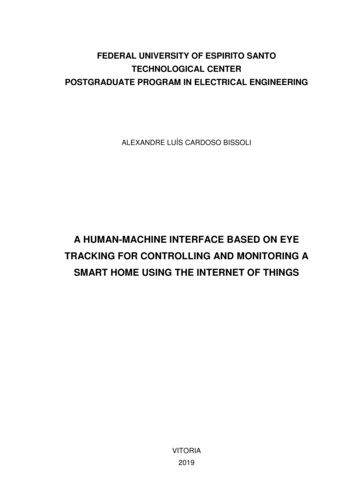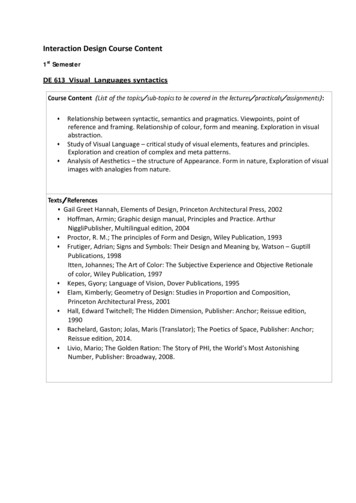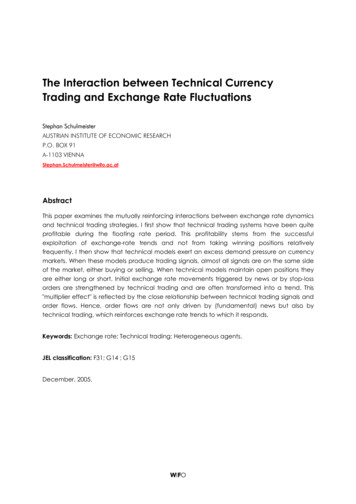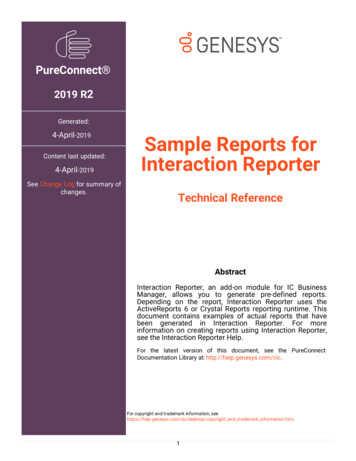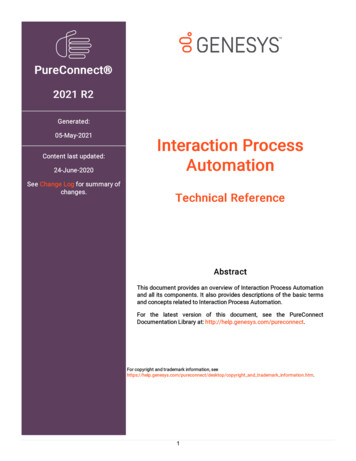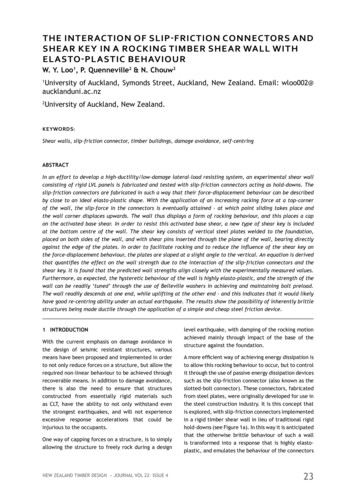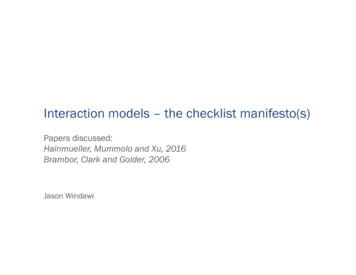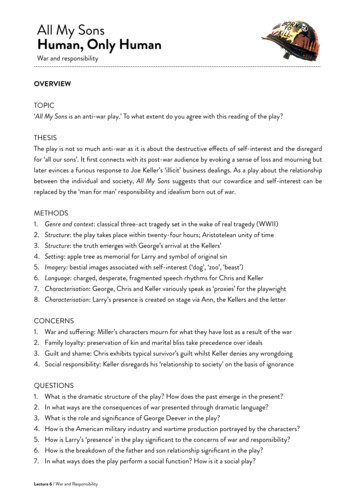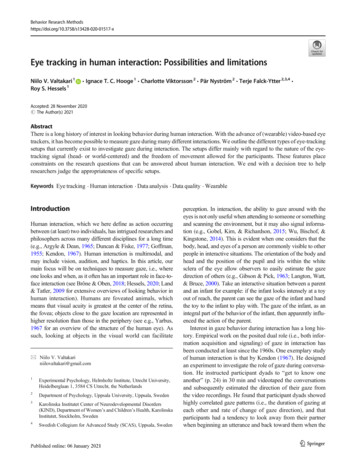
Transcription
Behavior Research ye tracking in human interaction: Possibilities and limitationsNiilo V. Valtakari 1Roy S. Hessels 1&Ignace T. C. Hooge 1 & Charlotte Viktorsson 2 & Pär Nyström 2 & Terje Falck-Ytter 2,3,4 &Accepted: 28 November 2020# The Author(s) 2021AbstractThere is a long history of interest in looking behavior during human interaction. With the advance of (wearable) video-based eyetrackers, it has become possible to measure gaze during many different interactions. We outline the different types of eye-trackingsetups that currently exist to investigate gaze during interaction. The setups differ mainly with regard to the nature of the eyetracking signal (head- or world-centered) and the freedom of movement allowed for the participants. These features placeconstraints on the research questions that can be answered about human interaction. We end with a decision tree to helpresearchers judge the appropriateness of specific setups.Keywords Eye tracking . Human interaction . Data analysis . Data quality . WearableIntroductionHuman interaction, which we here define as action occurringbetween (at least) two individuals, has intrigued researchers andphilosophers across many different disciplines for a long time(e.g., Argyle & Dean, 1965; Duncan & Fiske, 1977; Goffman,1955; Kendon, 1967). Human interaction is multimodal, andmay include vision, audition, and haptics. In this article, ourmain focus will be on techniques to measure gaze, i.e., whereone looks and when, as it often has an important role in face-toface interaction (see Brône & Oben, 2018; Hessels, 2020; Land& Tatler, 2009 for extensive overviews of looking behavior inhuman interaction). Humans are foveated animals, whichmeans that visual acuity is greatest at the center of the retina,the fovea; objects close to the gaze location are represented inhigher resolution than those in the periphery (see e.g., Yarbus,1967 for an overview of the structure of the human eye). Assuch, looking at objects in the visual world can facilitate* Niilo V. Valtakariniilovaltakari@gmail.com1Experimental Psychology, Helmholtz Institute, Utrecht University,Heidelberglaan 1, 3584 CS Utrecht, the Netherlands2Department of Psychology, Uppsala University, Uppsala, Sweden3Karolinska Institutet Center of Neurodevelopmental Disorders(KIND), Department of Women’s and Children’s Health, KarolinskaInstitutet, Stockholm, Sweden4Swedish Collegium for Advanced Study (SCAS), Uppsala, Swedenperception. In interaction, the ability to gaze around with theeyes is not only useful when attending to someone or somethingand scanning the environment, but it may also signal information (e.g., Gobel, Kim, & Richardson, 2015; Wu, Bischof, &Kingstone, 2014). This is evident when one considers that thebody, head, and eyes of a person are commonly visible to otherpeople in interactive situations. The orientation of the body andhead and the position of the pupil and iris within the whitesclera of the eye allow observers to easily estimate the gazedirection of others (e.g., Gibson & Pick, 1963; Langton, Watt,& Bruce, 2000). Take an interactive situation between a parentand an infant for example: if the infant looks intensely at a toyout of reach, the parent can see the gaze of the infant and handthe toy to the infant to play with. The gaze of the infant, as anintegral part of the behavior of the infant, then apparently influenced the action of the parent.Interest in gaze behavior during interaction has a long history. Empirical work on the posited dual role (i.e., both information acquisition and signaling) of gaze in interaction hasbeen conducted at least since the 1960s. One exemplary studyof human interaction is that by Kendon (1967). He designedan experiment to investigate the role of gaze during conversation. He instructed participant dyads to “get to know oneanother” (p. 24) in 30 min and videotaped the conversationsand subsequently estimated the direction of their gaze fromthe video recordings. He found that participant dyads showedhighly correlated gaze patterns (i.e., the duration of gazing ateach other and rate of change of gaze direction), and thatparticipants had a tendency to look away from their partnerwhen beginning an utterance and back toward them when the
Behav Resutterance was close to its end. This type of early research onlooking behavior in interaction mostly relied on using an external observer to provide an estimate of where someone islooking (see Argyle & Cook, 1976; Goodwin, 1981 for otherexamples of early interaction studies). With advances in technology, there has been an emergence of new methods to measure gaze more accurately and objectively, using devices commonly known as eye trackers (see Jongerius, Hessels, Romijn,Smets, & Hillen, 2020 for a review of the methods used tostudy eye contact).Interest in using eye tracking to measure gaze has increasedover the past years. Reviews have been written on the breadthof eye-tracking research (Duchowski, 2002), on differencesbetween eye-tracking “in the wild” (i.e., with unrestrictedmovement of the body and head) and in the lab (i.e., withrestricted movement of the body and head) (Lappi, 2015),and on eye movements in various situations (e.g., Hayhoe &Ballard, 2005, 2014). However, to the best of our knowledge,the possibilities and limitations of eye tracking in relation tothe study of face-to-face human interaction have not yet beensummarized in a structured way.1 The main goals of this review are (1) to describe the different types of eye-trackingsetups that have been used to investigate human interactionso far, (2) to provide a scoping overview of the eye-trackingresearch that has been conducted on human interaction, and(3) to guide researchers into choosing the optimal setup byidentifying and discussing the constraints that eye-trackingsetups place on the research questions that can be asked abouthuman interaction. With these three aims put together, ourobjective is to provide a structured overview of the study oflooking behavior in human interaction, aimed particularly atresearchers starting out in the field.Eye trackingBefore we discuss eye tracking in the context of human interaction, we first introduce the principles behind eye tracking. Eyetrackers are devices that can be used to estimate the gaze direction of a person. Most modern video-based eye trackers areequipped with one or two cameras and one or more infraredlight sources. The infrared light illuminates the eyes and facecreating a corneal reflection (CR), while the camera films theeyes and the face. Eye trackers compute the point of regard (i.e.,the point where gaze is directed at, such as a location on a1Although we focus here on face-to-face interaction, i.e., when people can seeor look at each other, there are also other kinds of eye-tracking studies involving interaction. Niehorster, Cornelissen, Holmqvist, and Hooge (2019), forexample, measured the gaze of participants who either collaborated with eachother or competed against each other in a visual search task. In another example, Richardson, Dale, and Kirkham (2007) investigated the gaze of participants who viewed images on a computer screen while conversing with eachother through headsets.computer screen) by comparing the location of the pupil in thecamera image to the location of the CR in the camera image(Holmqvist et al., 2011). Generally speaking, an eye-trackingexperiment minimally involves an eye tracker and a participant.The type, model, and number of eye trackers used varies between experiments, as does the placement of the eye tracker inrelation to the participant. The overall combination of eye trackerand participant placement is what we hereafter refer to as an eyetracking setup. Next, we will discuss the different types of eyetracking setups that have been used to investigate looking behavior in face-to-face human interaction. As this is a review ofeye tracking in human interaction, we do not provide a detaileddiscussion of the general problems faced in eye-tracking research. Readers interested in the more general aspects of eyetracking research are referred to Holmqvist et al. (2011) orHolmqvist and Andersson (2017) for good starting points.The types of eye-tracking setups used in interaction research can be divided into three categories based on the freedom for the participant and nature of the eye-tracking signal(see Fig. 1 for an illustration of these categories): (1) Setupswith unrestrained head and an eye-tracking signal with a reference frame attached to the head (Fig. 1a). These setups willbe referred to as head-free setups. An example of a head-freesetup may contain one or more wearable eye trackers.Wearable eye trackers are mounted on the head of the participant, and usually mimic the appearance of glasses. They aretypically equipped with a scene camera to provide a view ofwhat the wearer is looking at. Early examples of wearable eyetracking studies are given by Land, Mennie, and Rusted(1999), who had participants make a cup of tea while wearingan eye tracker, and Pelz and Canosa (2001), who had participants perform tasks that required unrestricted movement,such as walking to a washroom to wash and dry their hands.(2) Setups with an unrestrained head and an eye tracker signalthat has a reference frame that is attached to the world (Fig.1b). We will refer to these setups as head-boxed setups. Anexample of a head-boxed setup may contain one or moreremote eye trackers. Remote eye trackers are typically placedat a fixed location in front of the participant (see Merchant,Morrissette, & Porterfield, 1974 for an example of the firstremote eye tracker that allowed for movement of the head).(3) Setups with a restrained head and an eye-tracking signalthat has a reference frame attached to the world (Fig. 1c).These we will refer to as head-restricted setups. A typicalexample of a head-restricted setup contains one or moretower-mounted eye trackers or remote eye trackers with a chinrest. Tower-mounted eye trackers restrict both the chin and thehead and film the eyes from above (see Fig. 1c in Holleman,Hooge, Kemner, & Hessels, 2020 for a picture of a typicaltower-mounted eye tracker).In addition to the distinction between head-free, headboxed, and head-restricted, eye-tracking setups found in theinteraction literature can further be divided into two additional
Behav ResabcFig. 1 An illustration of the different types of eye-tracking setups: a An example of a head-free setup containing a wearable eye tracker. b An example ofa head-boxed setup containing a remote eye tracker. c An example of a head-restricted setup containing a remote eye tracker and a chin restcategories: single and dual eye-tracking setups. With singleeye-tracking setups we refer to setups where the gaze of onlyone of the participants in an interactive situation is recordedusing an eye tracker. Dual eye-tracking setups, on the otherhand, allow for the simultaneous recording of the gaze of twoparticipants using eye trackers. Table 1 contains and overviewof the face-to-face interaction studies we have reviewed categorized by the type of eye-tracking setup and whether it wassingle or dual. The table contains as many relevant studies foreach category as we are aware of. Some categories containfewer examples as they have been less popular (although notnecessarily less effective or efficient) choices for eye-trackingsetups in interaction research. We make a further divisionbetween head-boxed setups with and without screens, as thischoice is likely to have implications on e.g., the questions thatcan be asked with the setup and the ease of data analysis. Wewill return to this point in the section dedicated to head-boxedsetups. The division of setups with and without a screen hasnot been made for head-restricted setups as we are only awareof studies where screens have been used.The concept of single and dual eye-tracking setups can beexpanded to setups containing even more eye trackers, whichTable 1 Examples of interaction studies categorized by the type of eye-tracking setup and whether it was single or dual. Studies are orderedchronologically. Note that we have separated studies using head-boxed setups based on whether they use screens for reasons explained in the main textSingleDualHead-freeHead-boxed with screenHead-boxed without screenHead-restrictedGullberg and Holmqvist (1999)Gullberg and Holmqvist (2006)Hanna and Brennan (2007)Nadig et al. (2010)Franchak et al. (2011)Damm et al. (2013)Freeth et al. (2013)Macdonald and Tatler (2013)Cañigueral et al. (2018)Freeth and Bugembe (2019)Fu et al. (2019)Yamamoto et al. (2019)Haensel et al. (2020)Broz et al. (2012)Yu and Smith (2013)Ho et al. (2015)Yu and Smith (2016)Macdonald and Tatler (2018)Franchak et al. (2018)Rogers et al. (2018)Yu et al. (2019)Cañigueral et al. (2020)Merin et al. (2007)von dem Hagen andBright (2017)Haith et al. (1977)Gredebäck et al. (2010)Falck-Ytter (2015)Thorup et al. (2016)Nyström et al. (2017)Thorup et al. (2018)Nyström et al. (2019)Holleman, Hessels,et al. (2020)Hessels et al. (2017)Hessels, Holleman,et al. (2018)Hessels et al. (2019)Nakamura et al. (2017)
Behav Rescould then be referred to as triple setups, quadruple setups, andso on. Adding a new eye tracker to a setup will typically bringincreased complexity to how the setup operates (e.g., in termsof required connections, computing power, and synchronizationbetween components) and may affect how the eye-tracking datait provides is analyzed. It is, however, important to note that thismight not always be the case. For example, in studies where thesynchronicity of measures between participants is not of interestor in studies where the same global eye-tracking measures areused for every participant, adding another eye tracker is notlikely to complicate data analysis. An example of global eyetracking measures can be found in a study by Dowiasch, Marx,Einhäuser, and Bremmer (2
1 Experimental Psychology, Helmholtz Institute, Utrecht University, Heidelberglaan 1, 3584 CS Utrecht, the Netherlands 2 Department of Psychology, Uppsala University, Uppsala, Sweden 3 Karolinska Institutet Center of Neurodevelopmental Disorders (KIND),DepartmentofWomen ’sandChildren’sHealth,Karolinska Institutet, Stockholm, Sweden 4 Swedish Collegium for Advanced
